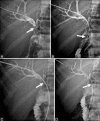Percutaneous transhepatic techniques for management of biliary anastomotic strictures in living donor liver transplant recipients
- PMID: 28515595
- PMCID: PMC5385786
- DOI: 10.4103/0971-3026.202950
Percutaneous transhepatic techniques for management of biliary anastomotic strictures in living donor liver transplant recipients
Abstract
Aim: To retrospectively analyze the percutaneous transhepatic techniques and their outcome in the management of biliary strictures in living donor liver transplant (LDLT) recipients.
Materials and methods: We retrieved the hospital records of 400 LDLT recipients between 2007 and 2015 and identified 45 patients with biliary strictures. Among them, 17 patients (37.8%) (Male: female = 13:4; mean age, 36.1 ± 17.5 years) treated by various percutaneous transhepatic biliary techniques alone or in combination with endoscopic retrograde cholangiopancreatography (ERCP) were included in the study. The technical and clinical success of the percutaneous management was analyzed.
Results: Anastomotic strictures associated with leak were found in 12/17 patients (70.6%). Ten out of 12 (83.3%) patients associated with leak had more than one duct-duct anastomoses (range, 2-3). The average duration of onset of stricture in patients with biliary leak was 3.97 ± 2.68 months and in patients with only strictures it was 14.03 ± 13.9 months. In 6 patients, endoscopic-guided plastic stents were placed using rendezvous technique, plastic stent was placed from a percutaneous approach in 1 patient, metallic stents were used in 2 patients, cholangioplasty was performed in 1 patient, N-butyl- 2-cyanoacrylate embolization was done in 1 child with biliary-pleural fistula, internal-external drain was placed in 1 patient, and only external drain was placed in 5 patients. Technical success was achieved in 12/17 (70.6%) and clinical success was achieved in 13/17 (76.5%) of the patients. Posttreatment mean time of follow-up was 19.4 ± 13.7 months. Five patients (29.4%) died (two acute rejections, one metabolic acidosis, and two sepsis).
Conclusions: Percutaneous biliary techniques are effective treatment options with good outcome in LDLT patients with biliary complications.
Keywords: Biliary tract; cholangiopancreatography; endoscopic retrograde; liver transplantation; stricture.
Conflict of interest statement
There are no conflicts of interest.
Figures







Similar articles
-
Endoscopic management of post-liver transplant billiary complications: A prospective study from tertiary centre in India.Indian J Gastroenterol. 2016 Jan;35(1):48-54. doi: 10.1007/s12664-016-0625-4. Epub 2016 Feb 13. Indian J Gastroenterol. 2016. PMID: 26873087
-
Current diagnosis and treatment of benign biliary strictures after living donor liver transplantation.World J Gastroenterol. 2016 Jan 28;22(4):1593-606. doi: 10.3748/wjg.v22.i4.1593. World J Gastroenterol. 2016. PMID: 26819525 Free PMC article. Review.
-
Management issues in post living donor liver transplant biliary strictures.World J Hepatol. 2016 Apr 8;8(10):461-70. doi: 10.4254/wjh.v8.i10.461. World J Hepatol. 2016. PMID: 27057304 Free PMC article. Review.
-
Endoscopic treatment of anastomotic biliary strictures after living donor liver transplantation: outcomes after maximal stent therapy.Gastrointest Endosc. 2013 Jan;77(1):47-54. doi: 10.1016/j.gie.2012.08.034. Epub 2012 Oct 11. Gastrointest Endosc. 2013. PMID: 23062758
-
Endoscopic retrograde cholangiography and percutaneous transhepatic cholangiodrainage in biliary strictures after liver transplantation: Long-term outcome predictors and influence on patient survival.Liver Int. 2019 Jun;39(6):1155-1164. doi: 10.1111/liv.13995. Epub 2019 Feb 21. Liver Int. 2019. PMID: 30367552
Cited by
-
Repeated balloon dilatation with long-term biliary drainage for treatment of benign biliary-enteric anastomosis strictures: A STROBE-compliant article.Medicine (Baltimore). 2020 Oct 30;99(44):e22741. doi: 10.1097/MD.0000000000022741. Medicine (Baltimore). 2020. PMID: 33126311 Free PMC article.
-
Role of percutaneous radiological treatment in biliary complications associated with adult left lobe living donor liver transplantation: a single-center experience.Diagn Interv Radiol. 2021 Jul;27(4):546-552. doi: 10.5152/dir.2021.20523. Diagn Interv Radiol. 2021. PMID: 33599206 Free PMC article.
-
Life-Saving Precision: Image-Guided Interventions Transforming Outcomes in Living-Donor Liver Transplant Complications.Cureus. 2025 Apr 2;17(4):e81613. doi: 10.7759/cureus.81613. eCollection 2025 Apr. Cureus. 2025. PMID: 40322429 Free PMC article.
-
Biliary complications after liver transplantation: A computed tomography and magnetic resonance imaging pictorial review.World J Gastroenterol. 2023 Jun 7;29(21):3257-3268. doi: 10.3748/wjg.v29.i21.3257. World J Gastroenterol. 2023. PMID: 37377585 Free PMC article. Review.
References
-
- Yazumi S, Chiba T. Biliary complications after a right-lobe living donor liver transplantation. J Gastroenterol. 2005;40:861–5. - PubMed
-
- Verdonk RC, Buis CI, Porte RJ, Van der Jagt EJ, Limburg AJ, Van den Berg AP, et al. Anastomotic biliary strictures after liver transplantation: Causes and consequences. Liver Transpl. 2006;12:726–35. - PubMed
-
- Mosca S, Militerno G, Guardascione MA, Amitrano L, Picciotto FP, Cuomo O. Late biliary tract complications after orthotopic liver transplantation: Diagnostic and therapeutic role of endoscopic retrograde cholangiopancreatography. J Gastroenterol Hepatol. 2000;15:654–60. - PubMed
-
- Thethy S, Thomson B, Pleass H, Wigmore SJ, Madhavan K, Akyol M, et al. Management of biliary tract complications after orthotopic liver transplantation. Clin Transplant. 2004;18:647–53. - PubMed
LinkOut - more resources
Full Text Sources
Other Literature Sources

